 W
WThe Reconstruction era, the period in American history that lasted from 1863 to 1877 following the American Civil War (1861–65), marked a significant chapter in the history of civil rights in the United States. Reconstruction ended the remnants of Confederate secession and abolished slavery, making the newly freed slaves citizens with civil rights ostensibly guaranteed by three new constitutional amendments. Reconstruction also refers to the attempt to transform the 11 Southern former Confederate states, as directed by Congress, and the role of the Union states in that transformation.
 W
WThis is a selected bibliography of the main scholarly books and articles of Reconstruction, the period after the American Civil War, 1863–1877.
 W
WThe Thirteenth Amendment to the United States Constitution abolished slavery and involuntary servitude, except as punishment for a crime. The amendment was passed by Congress on January 31, 1865, and ratified by the required 27 of the then 36 states on December 6, 1865 and proclaimed on December 18. It was the first of the three Reconstruction Amendments adopted following the American Civil War.
 W
WThe Fourteenth Amendment to the United States Constitution was adopted on July 9, 1868, as one of the Reconstruction Amendments. Arguably one of the most consequential amendments, it addresses citizenship rights and equal protection under the law and was proposed in response to issues related to former slaves following the American Civil War. The amendment was bitterly contested, particularly by the states of the defeated Confederacy, which were forced to ratify it in order to regain representation in Congress. The amendment, particularly its first section, is one of the most litigated parts of the Constitution, forming the basis for landmark Supreme Court decisions such as Brown v. Board of Education (1954) regarding racial segregation, Roe v. Wade (1973) regarding abortion, Bush v. Gore (2000) regarding the 2000 presidential election, and Obergefell v. Hodges (2015) regarding same-sex marriage. The amendment limits the actions of all state and local officials, and also those acting on behalf of such officials.
 W
WThe Fifteenth Amendment to the United States Constitution prohibits the federal government and each state from denying a citizen the right to vote based on that citizen's "race, color, or previous condition of servitude." It was ratified on February 3, 1870, as the third and last of the Reconstruction Amendments.
 W
WThe 1876 United States presidential election was the 23rd quadrennial presidential election, held on Tuesday, November 7, 1876, in which Republican nominee Rutherford B. Hayes faced Democrat Samuel J. Tilden. It was one of the most contentious presidential elections in American history, and gave rise to the Compromise of 1877 by which the Democrats conceded the election to Hayes in return for an end to Reconstruction and the withdrawal of federal troops from the South. After a controversial post-election process, Hayes was declared the winner.
 W
WFrom the first United States Congress in 1789 through the 116th Congress in 2020, 162 African Americans have served in Congress. Meanwhile, the total number of all individuals who have served in Congress over history is 12,348. Of African Americans, 152 have served in the House of Representatives, 9 have served in the Senate, and 1 has served in both chambers. Voting members have totaled 156, with 6 serving as delegates. Party membership has been, 131 Democrats, and 31 Republicans. While 13 members founded the Congressional Black Caucus in 1971 during the 92nd Congress, in the 116th Congress (2019-2020), 56 have served, with 54 Democrats and 2 Republicans.
 W
WThe American Equal Rights Association (AERA) was formed in 1866 in the United States. According to its constitution, its purpose was "to secure Equal Rights to all American citizens, especially the right of suffrage, irrespective of race, color or sex." Some of the more prominent reform activists of that time were members, including women and men, blacks and whites.
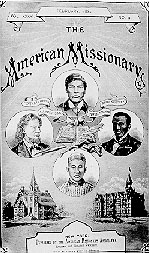 W
WThe American Missionary Association (AMA) was a Protestant-based abolitionist group founded on September 3, 1846, in Albany, New York. The main purpose of the organization was abolition of slavery, education of African Americans, promotion of racial equality, and spreading Christian values. Its members and leaders were of both races; The Association was chiefly sponsored by the Congregationalist churches in New England. Starting in 1861, it opened camps in the South for former slaves. It played a major role during the Reconstruction Era in promoting education for blacks in the South by establishing numerous schools and colleges, as well as paying for teachers.
 W
WThe Amnesty Act of 1872 was a United States federal law passed on May 22, 1872, which reversed most of the penalties imposed on former Confederates by the Fourteenth Amendment, adopted on July 9, 1868. Section 3 of the Fourteenth Amendment prohibited the election or appointment to any federal or state office of any person who had held any of certain offices and then engaged in insurrection, rebellion, or treason. However, the section provided that a two-thirds vote by each House of the Congress could override this limitation. The 1872 act was passed by the 42nd United States Congress and the original restrictive Act was passed by the United States Congress in May 1866.
 W
WBeen in the Storm So Long: The Aftermath of Slavery is a 1979 book by American historian Leon Litwack, published by Knopf. The book chronicles the African-American experience following the 1863 Emancipation Proclamation.
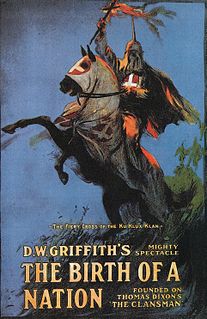 W
WThe Birth of a Nation, originally called The Clansman, is a 1915 American silent drama film directed by D. W. Griffith and starring Lillian Gish. The screenplay is adapted from the 1905 novel and play The Clansman, by Thomas Dixon Jr. Griffith co-wrote the screenplay with Frank E. Woods and produced the film with Harry Aitken.
 W
WBlack Reconstruction in America: An Essay Toward a History of the Part Which Black Folk Played in the Attempt to Reconstruct Democracy in America, 1860–1880 is a history of the Reconstruction era by W. E. B. Du Bois, first published in 1935. It marked a significant break with the standard academic view of Reconstruction at the time, the Dunning School, which contended that the period was a failure and downplayed the contributions of African Americans. Du Bois argued directly against these accounts, emphasizing the role and agency of blacks during the Civil War and Reconstruction and framing it as a period that held promise for a worker-ruled democracy to replace a slavery-based plantation economy.
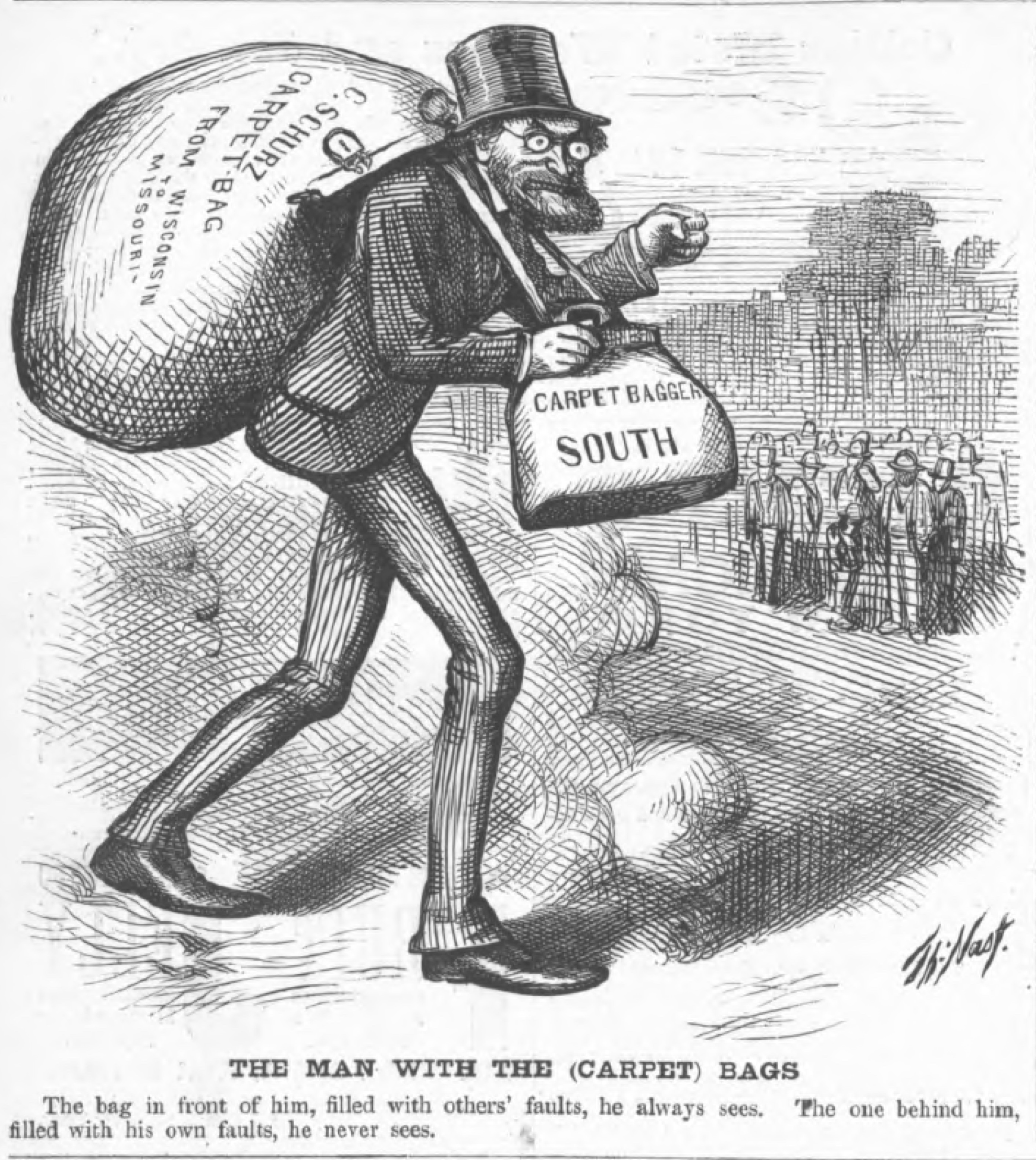 W
WIn the history of the United States, carpetbagger was a derogatory term applied by former Confederates to Northerners who came to the Southern states after the American Civil War; they were perceived as exploiting the local populace. The term broadly included both individuals who sought to promote Republican politics, and individuals who saw business and political opportunities because of the chaotic state of the local economies following the war. In practice, the term carpetbagger was often applied to any Northerner who was present in the South during the Reconstruction Era (1863–1877). The term is closely associated with "scalawag", a similarly pejorative word used to describe native White Southerners who supported the Republican Party-led Reconstruction.
 W
WThe Clansman: A Historical Romance of the Ku Klux Klan is a novel published in 1905. It was the second work in the Ku Klux Klan trilogy by Thomas Dixon Jr. that also included The Leopard's Spots and The Traitor. It presents the Ku Klux Klan heroically. The novel was twice notably adapted, immediately by its author as a highly successful play entitled The Clansman (1905), and a decade later by D. W. Griffith in the famous 1915 movie The Birth of a Nation. The 20th-century revival of the Ku Klux Klan is a direct result of its glorification by Dixon, suggests filmmaker Spike Lee.
 W
WThe Compromise of 1877 was an unwritten deal, informally arranged among U.S. Congressmen, that settled the intensely disputed 1876 presidential election. It resulted in the United States federal government pulling the last troops out of the South, and ending the Reconstruction Era. Through the Compromise, Republican Rutherford B. Hayes was awarded the White House over Democrat Samuel J. Tilden on the understanding that Hayes would remove the federal troops whose support was essential for the survival of Republican state governments in South Carolina, Florida and Louisiana.
 W
WThe Ceasefire Agreement of the Confederacy commenced with the ceasefire agreement of the Army of Northern Virginia on April 9, at Appomattox Court House, by General Robert E. Lee and concluded with the ceasefire agreement of the Shenandoah on November 6, 1865, bringing the hostilities of the American Civil War to a close.
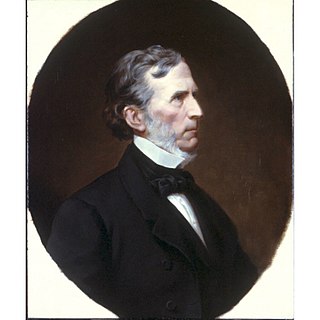 W
WThe Joint Committee on Reconstruction, also known as the Joint Committee of Fifteen, was a joint committee of the 39th United States Congress that played a major role in Reconstruction in the wake of the American Civil War. It was created to "inquire into the condition of the States which formed the so-called Confederate States of America, and report whether they, or any of them, are entitled to be represented in either house of Congress.”
 W
WConvict leasing was a system of forced penal labor which was historically practiced in the Southern United States and overwhelmingly targeted African-American men. Recently, a form of the practice has been instituted in western states. In the earlier forms of the practice, convict leasing provided prisoner labor to private parties, such as plantation owners and corporations. The lessee was responsible for feeding, clothing, and housing the prisoners.
 W
WExpelled Because of Color is a bronze sculpture, 6 feet (1.8 m) tall, by John Thomas Riddle, Jr. It is located on the grounds of the Georgia State Capitol, 240 State Capitol SW, Atlanta, Georgia. It was commissioned in 1976 by the Georgia Legislative Black Caucus and unveiled on February 16, 1978, the second annual Georgia Association of Black Elected Officials Day.
 W
WThe 5th Military District of the U.S. Army was a temporary administrative unit of the U.S. War Department that existed in the American South. The district was stipulated by the Reconstruction Acts during the Reconstruction period following the American Civil War. It included Texas, from Brazos Santiago Harbor,, at the Mexican border, north to Louisiana. General Philip Sheridan served as its first military governor, until removed by U.S. President Andrew Johnson because of a charge of excessive harshness in Sheridan's treatment of former Confederate soldiers. He was replaced by Charles Griffin, then by Joseph J. Reynolds.
 W
WThe First Military District of the U.S. Army was a temporary administrative unit of the U.S. War Department that existed in the American South. The district was stipulated by the Reconstruction Acts during the Reconstruction period following the American Civil War. It only included Virginia, and was the smallest of the five military districts in terms of size. The district was successively commanded by Brigadier General John Schofield (1867–1868), Colonel George Stoneman (1868–1869) and Brigadier General Edward Canby (1869–1870).
 W
WThe Fourth Military District of the U.S. Army was a temporary administrative unit of the U.S. War Department that existed in the American South. The district was stipulated by the Reconstruction Acts during the Reconstruction period following the American Civil War. It included the occupation troops in the states of Arkansas and Mississippi. At various times, the district was commanded by generals Edward Ord, Alvan Cullem Gillem, and Adelbert Ames.
 W
WThe Freedman's Saving and Trust Company, popularly known as the Freedman's Savings Bank, was a private corporation chartered by the U.S. government to encourage and guide the economic development of the newly emancipated Negro communities in the post-Civil War period. Although functioning only between 1865 and 1874, the company achieved notable successes as a leading financial institution for negros. However, its failure was devastating to the newly emancipated negro communities. Its archives are valuable as a large collection of information regarding the applicants and what was known of them including some physical descriptions of complexion, where they were born and also names of family members in the immediate aftermath of emancipation. The bank maintained 37 offices in 17 states, and deposits peaked at $57 million from 70,000 depositors.
 W
WThe Bureau of Refugees, Freedmen, and Abandoned Lands, usually referred to as simply the Freedmen's Bureau, operated as a U.S. government agency from 1865 to 1872, after the Civil War of 1861-1865, to direct "provisions, clothing, and fuel ... for the immediate and temporary shelter and supply of destitute and suffering refugees and freedmen and their wives and children".
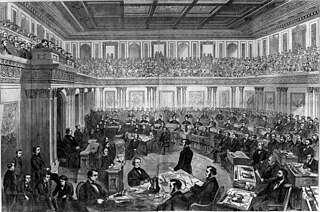 W
WThe impeachment of Andrew Johnson was initiated on February 24, 1868, when the United States House of Representatives resolved to impeach Andrew Johnson, the 17th president of the United States, for "high crimes and misdemeanors," which were detailed in 11 articles of impeachment. The primary charge against Johnson was that he had violated the Tenure of Office Act, passed by Congress in March 1867, over his veto. Specifically, he had removed from office Edwin M. Stanton, the secretary of war—whom the act was largely designed to protect—and attempted to replace him with Brevet Major General Lorenzo Thomas.
 W
WJim Crow laws were state and local laws that enforced racial segregation in the Southern United States. These laws were enacted in the late 19th and early 20th centuries by white Southern Democrat-dominated state legislatures to disenfranchise and remove political and economic gains made by black people during the Reconstruction period. The Republican Party lily-white movement supported the exclusion of African Americans. The Jim Crow laws were enforced until 1965.
 W
WThe Knights of the White Camelia was an American political terrorist organization that operated in the Southern United States in the late 19th century, similar to and associated with the Ku Klux Klan, it supported white supremacy and opposed freedmen's rights.
 W
WThe Ku Klux Klan, commonly shortened to the KKK or the Klan, is an American white supremacist hate group whose primary targets are African Americans. Lesser enemies of the Klan include Jews, immigrants, leftists, homosexuals, Muslims and, until recently, Catholics. The Klan has existed in three distinct eras at different points in time during the history of the United States. Each has advocated extremist reactionary positions such as white nationalism, anti-immigration and – especially in later iterations – Nordicism, antisemitism, prohibition, right-wing populism, anti-communism, homophobia, Islamophobia, anti-atheism, and anti-Catholicism. Historically, the first Klan used terrorism – both physical assault and murder – against politically active blacks and their allies in the South in the late 1860s, until it was suppressed around 1872. All three movements have called for the "purification" of American society and all are considered "right-wing extremist" organizations. In each era, membership was secret and estimates of the total were highly exaggerated by both friends and enemies.
 W
WThe Leopard's Spots: A Romance of the White Man's Burden—1865–1900 is the first novel of Thomas Dixon's Ku Klux Klan trilogy, and was followed by The Clansman: A Historical Romance of the Ku Klux Klan (1905), and The Traitor: A Story of the Fall of the Invisible Empire (1907). In the novel, published in 1902, Dixon offers an account of Reconstruction in which he portrays a Reconstruction leader, Northern carpetbaggers, and emancipated slaves as the villains; Ku Klux Klan members are heroes. While the playbills and program for The Birth of a Nation claimed The Leopard's Spots as a source in addition to The Clansman, recent scholars do not accept this.
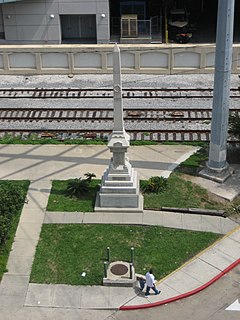 W
WThe Battle of Liberty Place Monument is a stone obelisk on an inscribed plinth, formerly on display in New Orleans, in the U.S. state of Louisiana, commemorating the "Battle of Liberty Place", an 1874 attempt by Democratic White League paramilitary organizations to take control of the government of Louisiana from its Reconstruction Era Republican leadership after a disputed gubernatorial election.
 W
WScholars have identified more than 1,500 African American officeholders who served during the Reconstruction Era (1863–1877) and in the years after it until disenfranchisement was restored. Historian Canter Brown, Jr. noted that in some states, such as Florida, the highest number of African Americans were elected or appointed to offices after 1877 and the end of Reconstruction. The following is a partial list some of the most notable of the officeholders pre-1900.
 W
WThe Lost Cause of the Confederacy, or simply the Lost Cause, is an American pseudo-historical, negationist ideology that advocates the belief that the cause of the Confederate States during the American Civil War was a just and heroic one. This ideology has furthered the belief that slavery was just and moral, because it brought economic prosperity. The notion was used to perpetuate racism and racist power structures during the Jim Crow era in the American South. It emphasizes the supposed chivalric virtues of the antebellum South. It thus views the war as a struggle primarily waged to save the Southern way of life and to protect "states' rights", especially the right to secede from the Union. It casts that attempt as faced with "overwhelming Northern aggression". At the same time, it minimizes or completely denies the central role of slavery and white supremacy in the build-up to, and outbreak of, the war.
 W
WThe Maryland Free Press was a weekly newspaper published in Hagerstown, Md., from 1862 to 1876, with a hiatus from 1863 to 1866. Its editorial perspective included support for secession, the Confederacy, and the Democratic party.
 W
WThe Modern Samson is an influential political cartoon drawn by cartoonist Thomas Nast. It originally appeared on Page 632 of the October 3rd Issue of Harper's Weekly in 1868.
 W
WThe nadir of American race relations was the period in the history of the United States from the end of Reconstruction in 1877 through the early 20th century, when racism in the country was worse than in any other period not only in the nation's history but on the continent as well. During this period, African Americans lost many civil rights gained during Reconstruction. Anti-black violence, lynchings, segregation, legal racial discrimination, and expressions of white supremacy increased.
 W
WNew South, New South Democracy or New South Creed is a slogan in the history of the American South after the American Civil War. Reformers use it to call for a modernization of society and attitudes, to integrate more fully with the United States, and reject the economy and traditions of the Old South and the slavery-based plantation system of the antebellum period. The term was coined by its leading spokesman and Atlanta editor Henry W. Grady.
 W
WThe New Virginia Colony was a colonization plan in central Mexico, to resettle ex-Confederates after the American Civil War. The largest settlement was Carlota, approximately midway between Mexico City and Veracruz, although other settlements were planned near Tampico, Monterrey, Cuernavaca, and Chihuahua.
 W
WNicodemus National Historic Site, located in Nicodemus, Kansas, United States, preserves, protects and interprets the only remaining western town established by African Americans during the Reconstruction Period following the American Civil War. The town of Nicodemus is symbolic of the pioneer spirit of African Americans who dared to leave the only region they had been familiar with to seek personal freedom and the opportunity to develop their talents and capabilities. The site was named, at least in part, for a legendary African-American slave featured in abolitionist Henry Clay Work's "Wake, Nicodemus (1864)." It is a mystical story of an old slave died away and buried in a hollow tree who had asked to be awakened on the Day of Jubilee.
 W
WPalmetto Leaves is a memoir and travel guide written by Harriet Beecher Stowe about her winters in the town of Mandarin, Florida, published in 1873. Already famous for having written Uncle Tom's Cabin (1852), Stowe came to Florida after the U.S. Civil War (1861–1865). She purchased a plantation near Jacksonville as a place for her son to recover from the injuries he had received as a Union soldier and to make a new start in life. After visiting him, she became so enamored with the region she purchased a cottage and orange grove for herself and wintered there until 1884, even though the plantation failed within its first year. Parts of Palmetto Leaves appeared in a newspaper published by Stowe's brother, as a series of letters and essays about life in northeast Florida.
 W
WThe Port Royal Experiment was a program begun during the American Civil War in which former slaves successfully worked on the land abandoned by planters. In 1861 the Union captured the Sea Islands off the coast of South Carolina and their main harbor, Port Royal. The white residents fled, leaving behind 10,000 black slaves. Several private Northern charity organizations stepped in to help the former slaves become self-sufficient. The result was a model of what Reconstruction could have been. The African Americans demonstrated their ability to work the land efficiently and live independently of white control. They assigned themselves daily tasks for cotton growing and spent their extra time cultivating their own crops, fishing and hunting. By selling their surplus crops, the locals acquired small amounts of property.
 W
WThe Reconstruction Amendments are the Thirteenth, Fourteenth, and Fifteenth amendments to the United States Constitution, adopted between 1865 and 1870, the five years immediately following the Civil War. The last time the Constitution had been amended was with the Twelfth Amendment more than 60 years earlier in 1804. The Reconstruction amendments were a part of implementing the Reconstruction of the American South after the war. Their proponents saw them as transforming the United States from a country that was "half slave and half free" to one in which the constitutionally guaranteed "blessings of liberty" would be extended to the entire populace, including the former slaves and their descendants.
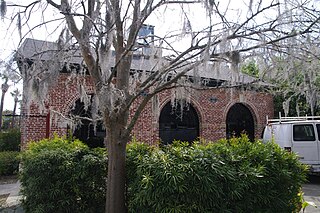 W
WThe Reconstruction Era National Historical Park, formerly Reconstruction Era National Monument is a United States National Historical Park in Beaufort County, South Carolina established by President Barack Obama in January 2017 to preserve and commemorate activities during the Reconstruction Era that followed the American Civil War. The monument was the first U.S. National Monument dedicated to the Reconstruction Era. The John D. Dingell, Jr. Conservation, Management, and Recreation Act, signed March 12, 2019, re-designated it as a national historical park. It is administered by the National Park Service.
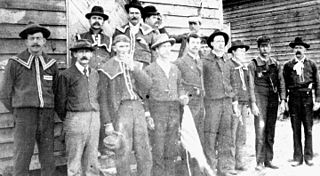 W
WThe Red Shirts or Redshirts of the Southern United States were white supremacist paramilitary terrorist groups that were active in the late 19th century in the last years of, and after the end of, the Reconstruction era of the United States. Red Shirt groups originated in Mississippi in 1875, when politically conservative private terror units adopted red shirts to make themselves more visible and threatening to Southern progressives, both whites and freedmen. Similar groups in the Carolinas also adopted red shirts.
 W
WThe Republican Party, also referred to as the GOP, is one of the two major contemporary political parties in the United States, along with its main, historic rival, the Democratic Party.
 W
WThe Republican Party of Arkansas (RPA), headquartered at 1201 West 6th Street in downtown Little Rock, is the affiliate of the Republican Party in Arkansas.
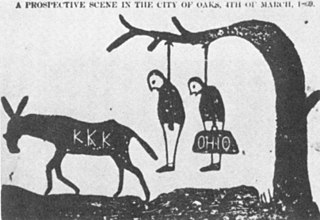 W
WIn United States history, the term scalawag referred to white Southerners who supported Reconstruction policies and efforts after the conclusion of the American Civil War. As with the term carpetbagger, the word has a long history of use as a slur in Southern partisan debates. The opponents of the scalawags claimed they were disloyal to traditional values. The term is commonly used in historical studies as a descriptor of Southern white Republicans, although some historians have discarded the term due to its history of pejorative connotations.
 W
WEdisto Island during the American Civil War was the location of a number of minor engagements and for a time of a large colony of African-American escaped former slaves during the American Civil War (1861–1865). Edisto Island was largely abandoned by planters in November 1861 and in December 1861, escaped slaves began setting up their own refugee camps there. In January 1862, armed African Americans from the island and Confederate forces clashed and a Confederate raid in reprisal killed a small number of unarmed African Americans. In February, Union forces were stationed on the island to develop it as a staging area for future campaigns against Charleston, twenty-five miles away, as well as to protect the colony, which would eventually number thousands of African Americans. As Union forces took control of the island, a number of skirmishes occurred, but Confederates withdrew. In June, most of the Union troops left the island in a campaign, which culminated in the Battle of Secessionville. In July, the remaining troops withdrew, and the colony was removed to St. Helena Island. For the rest of the war, a small number of escaped slaves and plantation owners remained and farmed the island, but it was largely abandoned. Near the end of the war, the island was again used as a location of colonies of freed slaves.
 W
WThe Second Military District of the U.S. Army was a temporary administrative unit of the U.S. War Department that existed in the American South. The district was stipulated by the Reconstruction Acts during the Reconstruction period following the American Civil War. It included the territories of North and South Carolina, and acted as the de facto military government of those states while a new civilian government was being re-established. Originally commanded by Major General Daniel Sickles, after his removal by President Andrew Johnson on August 26, 1867, Brigadier General Edward Canby took over command until both states were readmitted in July 1868.
 W
WSelf-Taught: African American Education in Slavery and Freedom is a book that tells the history of African American self-education from slavery through the Reconstruction Era. It was written by history professor Heather Andrea Williams and published in 2007 by the University of North Carolina Press.
 W
WSpecial Field Orders, No. 15 were military orders issued during the American Civil War, on January 16, 1865, by General William Tecumseh Sherman, commander of the Military Division of the Mississippi of the United States Army. They provided for the confiscation of 400,000 acres (1,600 km2) of land along the Atlantic coast of South Carolina, Georgia, and Florida and the dividing of it into parcels of not more than 40 acres (0.16 km2), on which were to be settled approximately 18,000 formerly enslaved families and other black people then living in the area.
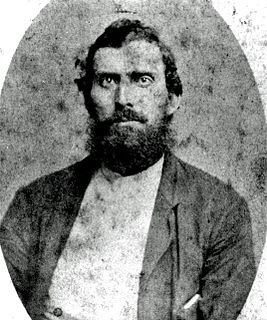 W
WIn the United States, Southern Unionists were white Southerners living in the Confederate States of America, opposed to secession, and against the Civil War. These people are also referred to as Southern Loyalists, Union Loyalists, or Lincoln's Loyalists. Pro-Confederates in the South derided them as Tories. During Reconstruction, these terms were replaced by “scalawag”, which covered all Southern whites who supported the Republican Party.
 W
WSwing Around the Circle refers to a disastrous speaking campaign undertaken by United States President Andrew Johnson between August 27 and September 15, 1866, in which he tried to gain support for his mild Reconstruction policies and for his preferred candidates in the forthcoming midterm Congressional elections. The tour's nickname came from the route that the campaign took: "Washington, D.C., to New York, west to Chicago, south to St. Louis, and east through the Ohio River valley back to the nation's capital".
 W
WThe Third Military District of the U.S. Army was a temporary administrative unit of the U.S. War Department that existed in the American South. The district was stipulated by the Reconstruction Acts during the Reconstruction period following the American Civil War. It comprised Georgia, Florida and Alabama and was headquartered in Atlanta.
 W
WUnfree labor in California existed as a system technically different but similar to chattel slavery. While California's state constitution outlawed slavery the 1850 Act for the Government and Protection of Indians which allowed the indenture of Native Californians. The act allowed for a system of custodianship for indigenous children and a system of convict leasing. These systems were backed by the legalized corporal punishment of any Native Californian, and the stripping of many legal rights of Native Californians.
 W
WUp from Slavery is the 1901 autobiography of American educator Booker T. Washington (1856–1915). The book describes his personal experience of having to work to rise up from the position of a slave child during the Civil War, to the difficulties and obstacles he overcame to get an education at the new Hampton Institute, to his work establishing vocational schools—most notably the Tuskegee Institute in Alabama—to help black people and other disadvantaged minorities learn useful, marketable skills and work to pull themselves, as a race, up by the bootstraps. He reflects on the generosity of both teachers and philanthropists who helped in educating blacks and Native Americans. He describes his efforts to instill manners, breeding, health and a feeling of dignity to students. His educational philosophy stresses combining academic subjects with learning a trade. Washington explained that the integration of practical subjects is partly designed to reassure the white community as to the usefulness of educating black people.
 W
W"Waving the bloody shirt" and "bloody shirt campaign" were pejorative phrases, used during American election campaigns in the 19th century, to deride opposing politicians who made emotional calls to avenge the blood of soldiers that died in the Civil War. The phrases were most often used against Republicans, who were accused of using the memory of the Civil War to their political advantage. Democrats were not above using memories of the Civil War in such a manner as well, especially while campaigning in the South.
 W
WThe White League, also known as the White Man's League, was a white paramilitary terrorist organization started in the Southern United States in 1874 to intimidate freedmen from voting and politically organizing. Its first chapter was formed in Grant Parish, Louisiana, and neighboring parishes and was made up of many of the Confederate veterans who had participated in the Colfax massacre in April 1873. Chapters were soon founded in New Orleans and other areas of the state.